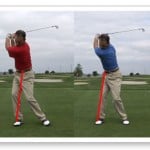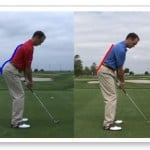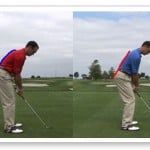Golfers’ Low Back Pain – The Core Issue
Swing Faults and Injuries – there is a relationship between swing faults and injuries, and poor biomechanics and swing faults. In this lesson we are going to look at how several common swing faults are related to injuries. We will also look at how abnormal biomechanics can create swing faults that create the pain.
Research indicates that a reverse spine angle is the number one swing fault that causes injury to the lower back. When we look at the majority of golfers they have pelvic torsions, muscle imbalance, and limited thoracic rotation. Generally there is mild to significant weakness in the glutes and abdominals. If we think back to the lesson on biomechanics, we find that this is a recipe for disaster. The disaster is that when these biomechanical conditions exist they create abnormal motion in the swing. When you have weakness in the glutes, with or without limited hip rotation, you will sway to the back swing side. That sway moves the hips up on the backswing side and creates a tilt of the spine toward the target…this is a reverse spine angle. From there you will begin a downswing, side bending, rotation, and flexion, under load from the opposite position of side bending, rotation, and extension…look out spine…you are going to be injured. If your golf swing has even slight reverse spine angle, you are prone to lower back injuries.

Lateral sway is movement of the pelvis to the back swing side of the golf swing. It is caused by hip rotation, gluteal weakness, tightness in the lateral aspect of the thigh, and/or anterior pelvic torsion. You do not have to have all of these physical problems, just one, and you will be at risk for lateral sway. Lateral sway as we mentioned earlier is related to reverse spine angle. The knee bone is connected to the leg bone….the leg bone is connected to the hip bone…the hip bone is connected to the pelvic bone…it’s all related and all works together.

Lateral slide is the down swing counterpart to lateral sway. It has the same physical causes as lateral sway: tight hip motion, weak glutes, etc. Lateral slide is related to hooks, and pulls, and a myriad of other swing faults. Lateral slide puts huge forces on the back swing side of the lower back. When the pelvis slides to the down swing side with flexion and rotation of the spine superimposed, there are huge forces put on the backswing side lower back. These forces cause disc and facet joint injuries. These injuries will get worse and worse over time.
[insert picture slide front here]
C-posture and S-posture are opposite extremes of the same problem. C-posture or forward bending of the spine puts huge forces on the lumbar discs. C-posture is related to loss of spine angle in the golf swing. S-Posture or backward bending of the spine puts great forces on the lumbar facet joints. S-posture is related to reverse spine angle as well. If you move into the rotation position of the back swing, and then move into S-posture or backward bending of the lumbar spine, you end up in reverse spine angle and you have back injury. Neutral spine is paramount to a healthy back and to biomechanically sound golf swings.


Unbalance Pelvis, when one side is in torsion, leads to reverse spine angles, lateral sways, and back injuries. As we reported earlier, unbalanced pelvis is caused in many cases, by tight hip flexors and lower back muscles and weak glutes and abdominals on one side of the body.
Are you beginning to see a trend? All of these swing problems are related to one another, and all of these swing problems are related to poor biomechanics of the lower back, pelvis and hips. Do you want to fix the hook or the slice? Do you want to hit the ball long and straight, consistently? Do you want to play golf without injuries to the lower back? The key to accomplishing this is to get rid of the swing faults. The way to get rid of swing faults is to correct the biomechanics of the lumbar spine, pelvis, and hip. Proper training will do this.
If you have any questions, please email them to me at [email protected].
Here’s to your healthy back and good golf.
Dave
